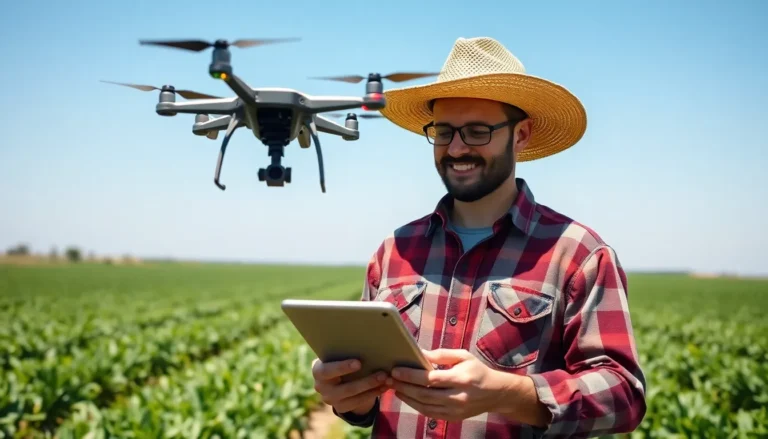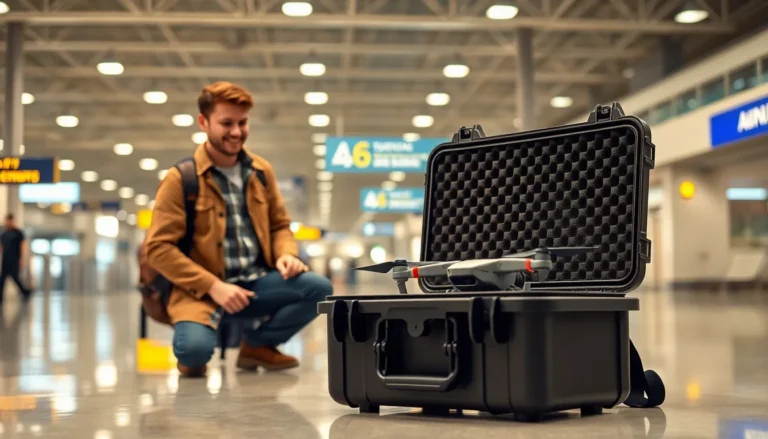Drones are soaring to new heights, and it’s not just because they’ve got a better view of the neighborhood. These flying marvels have transformed everything from photography to delivery services, making life a little more exciting—and a lot more efficient. Imagine a world where your pizza arrives before you can even say “extra cheese.” That’s the magic of drones!
Table of Contents
ToggleOverview of Drones Flying
Drones, also known as unmanned aerial vehicles (UAVs), provide numerous applications across various sectors. Many industries, such as agriculture, logistics, and public safety, utilize drones for efficiency. In agriculture, drones monitor crop health and optimize irrigation systems. They also assist in mapping the land for precise farming practices.
In logistics, drones revolutionize delivery services, enabling rapid transportation of goods. For example, companies like Amazon and UPS have begun testing drone delivery systems to enhance package delivery times. Delivery drones often cover distances up to 15 miles, significantly reducing wait times for customers.
Public safety departments adopt drones for surveillance and emergency response initiatives. Equipped with thermal imaging, drones improve search and rescue operations, making them highly effective tools in critical situations. They can cover large areas quickly, ensuring timely intervention when emergencies arise.
Drones enable photography and videography that captures stunning aerial views. Filmmakers and photographers use drones to create visuals that were once inaccessible. The demand for drone-captured content continues to grow, sparking interest in drone technology across creative industries.
Safety regulations govern drone operations, ensuring responsible use in airspace. The Federal Aviation Administration (FAA) has established guidelines that operators must follow, including altitude limits and no-fly zones. With adherence to regulations, flying drones safely enhances their utility.
The evolution of drone technology has transformed numerous sectors. Enhanced efficiency, rapid delivery, and improved safety features highlight the pivotal role of drones in modern society.
Types of Drones
Drones come in various types, each designed for specific uses. Understanding these categories helps in choosing the right drone for particular tasks.
Consumer Drones
Consumer drones cater to hobbyists and casual users. They often feature cameras, enabling aerial photography and videography, with models like DJI Mavic and Parrot Anafi leading the market. Most consumer drones offer user-friendly controls and stable flight performance. Prices typically range from $300 to $1,500, depending on the features included. Many enthusiasts use these drones for recreational activities, like racing and exploring landscapes. With advancements in technology, features like GPS navigation and obstacle avoidance are standard, making flying easier and safer.
Commercial Drones
Commercial drones serve various industries, such as agriculture, construction, and logistics. These drones enhance productivity, performing tasks like crop monitoring, surveying land, and delivering packages. For instance, companies like Amazon leverage commercial drones for expedient delivery services. Regulations surrounding commercial drone use are stricter, requiring pilots to possess licenses and adhere to FAA guidelines. Prices for commercial drones can vary significantly, starting around $1,000 and exceeding $15,000 for high-end models. Integration of advanced technologies, such as thermal imaging and LiDAR, boosts efficiency and data collection in professional applications.
Applications of Drones Flying
Drones are increasingly prevalent in various industries, showcasing their versatility and efficiency. Their applications span multiple sectors, including photography, surveying, agriculture, and more.
Aerial Photography and Videography
Aerial photography and videography leverage drones to capture stunning visuals from unique perspectives. Filmmakers and photographers benefit from drones equipped with high-resolution cameras. Popular events like weddings and sports games create opportunities for breathtaking footage. This technology facilitates stunning aerial photos that traditional methods struggle to achieve. In creative industries, content creators utilize drones to enhance marketing materials and social media engagement.
Surveying and Mapping
Surveying and mapping utilize drones for accurate data collection across extensive areas. Professionals in construction and real estate rely on drones for site assessments and progress tracking. Aerial surveys provide detailed topographical maps that save time and reduce costs. Equipped with specialized sensors, drones gather critical data for land development and planning. Many industries increasingly adopt drones to replace traditional methods of surveying.
Agriculture
Drones play a crucial role in modern agriculture, enhancing crop management processes. Farmers use drones to monitor crop health and assess irrigation needs effectively. This technology enables precise application of fertilizers and pesticides, reducing resource waste. Identifying crop health issues early can significantly impact yields. Furthermore, drones provide real-time data to farmers, allowing informed decisions that enhance productivity. The integration of this technology continues to transform agricultural practices.
Regulations and Safety Considerations
Drones operate in a regulated environment to ensure safe and responsible use. Both local and federal regulations govern drone flights, necessitating adherence for all operators.
Local and Federal Regulations
Federal Aviation Administration (FAA) mandates rules for drone operations across the United States. Operators must register their drones weighing over 0.55 pounds. Local regulations may include no-fly zones, which restrict flights near airports, stadiums, and schools. Community laws often address privacy concerns, so operators must understand local ordinances. Violations of these regulations can result in penalties, including fines and loss of flying privileges. Following these guidelines ensures safety and compliance while flying drones.
Safety Measures for Drone Operators
Operators should prioritize safety with comprehensive planning before flying. Conducting pre-flight checks ensures the drone is in good working condition. Operating within visual line-of-sight minimizes the risk of collisions with people and property. Additionally, maintaining a safe distance from crowds and sensitive areas protects the public and personal privacy. Using spotters during flights enhances awareness of surroundings and potential hazards. Lastly, ensuring adequate battery life before flight prevents unexpected landings and accidents. Following these safety measures significantly reduces risks associated with drone operations.
Future Trends in Drones Flying
Drones are set to experience significant advancements and growth in the coming years. Technological developments lead the way, enhancing their capabilities and applications across various sectors.
Technological Advancements
Innovative features drive the evolution of drones. Advanced artificial intelligence plays a crucial role, enabling autonomous flight and smart navigation systems. Integration of enhanced sensors improves data collection accuracy, transforming sectors like agriculture and real estate. Furthermore, developments in battery technology boost flight times, allowing longer missions. Each of these enhancements promotes efficiency and opens new operational possibilities.
Market Growth Predictions
The drone market shows promising growth potential. Analysts project a compound annual growth rate (CAGR) of 13.8% through 2029, driven by demand in industries such as logistics, agriculture, and surveillance. Increasing usage in commercial applications fuels investments, with companies expanding their fleets. For example, logistics firms are adopting drones for faster deliveries. As regulations evolve, more businesses will embrace drones, amplifying their presence in everyday operations.
Drones are reshaping the landscape of various industries and everyday life. Their versatility and efficiency make them invaluable tools in agriculture logistics and public safety. As technology advances and regulations adapt to accommodate these innovations the potential for drones continues to expand.
The increasing integration of drones into professional settings not only enhances productivity but also opens new avenues for creativity and exploration. With the drone market on a steady growth trajectory it’s clear that these aerial vehicles will play a crucial role in shaping the future. Embracing this technology responsibly will ensure a safe and exciting journey ahead in the world of drones.





